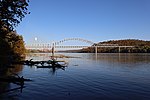Great Miami River

The Great Miami River (also called the Miami River) (Shawnee: Msimiyamithiipi) is a tributary of the Ohio River, approximately 160 miles (260 km) long, in southwestern Ohio and Indiana in the United States. The Great Miami originates at the man-made Indian Lake and flows south through the cities of Sidney, Piqua, Troy, Dayton, Middletown and Hamilton. The river is named for the Miami, an Algonquian-speaking Native American people who lived in the region during the early days of European settlement. They were forced to relocate to the west to escape pressure from European-American settlers. The region surrounding the Great Miami River is known as the Miami Valley. This term is used in the upper portions of the valley as a moniker for the economic-cultural region centered primarily on the Greater Dayton area. As the lower portions of the Miami Valley fall under the influence of Cincinnati and the Ohio River Valley, residents of the lower area do not identify with the Miami in the same way.
Excerpt from the Wikipedia article Great Miami River (License: CC BY-SA 3.0, Authors, Images).Great Miami River
I 275, Lawrenceburg Township
Geographical coordinates (GPS) Address Nearby Places Show on map
Geographical coordinates (GPS)
| Latitude | Longitude |
|---|---|
| N 39.108611111111 ° | E -84.814444444444 ° |
Address
Flannery Island
I 275
41080 Lawrenceburg Township
Indiana, United States
Open on Google Maps




